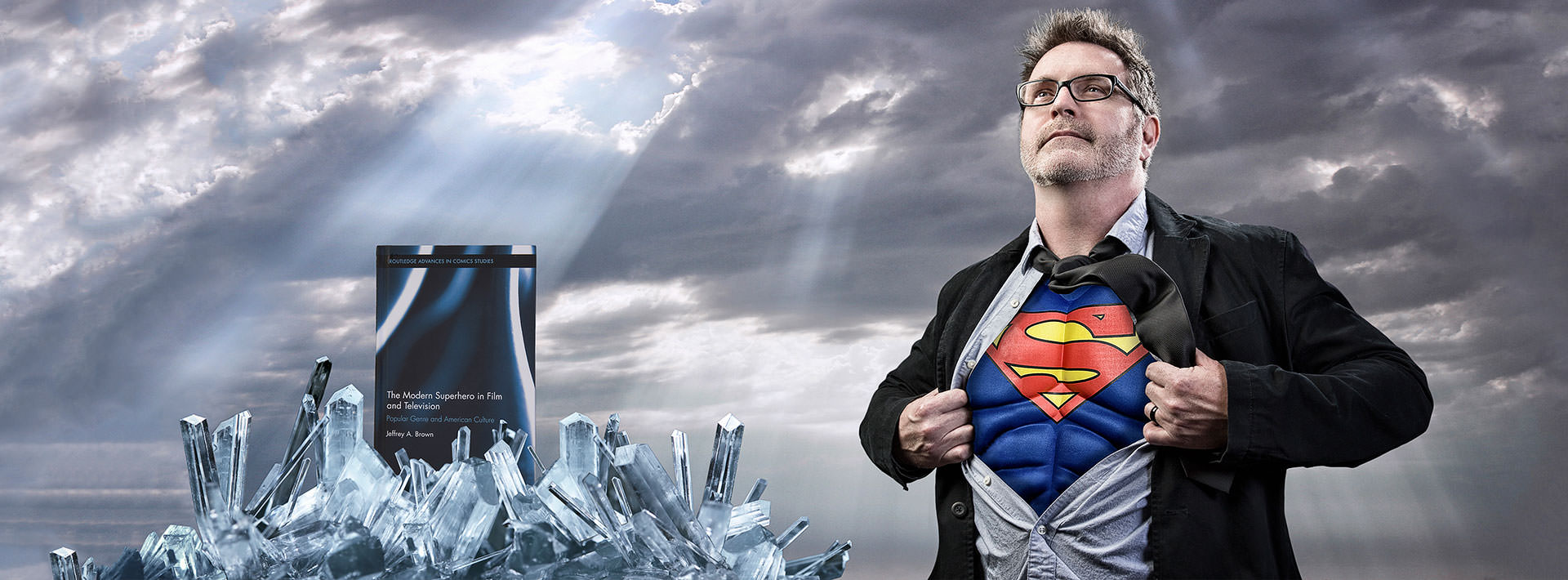Superheroes catapult to blockbuster status
BGSU pop culture professor’s book addresses cultural phenomenon

By Julie Carle
Superhero infatuation is at an all-time high. Superman and Batman are as well known as some of the most-beloved storybook characters. And more than 20 of the top 100 grossing films of all times are borne out of superhero comic book lore.
Dr. Jeffrey A. Brown, a professor of popular culture at Bowling Green State University, addresses the trend of exalted superhero status in his book, “The Modern Superhero in Film and Television.”
In the textbook, recently published by Routledge in its “Advances in Comics Studies” series, Brown says superheroes are stars of the big screen as well as television, and their fame crosses into merchandising of clothing, bags, toys, phone cases and collectibles. “The 21st century is a new golden age for superheroes,” he described in “characteristic hyperbolic comic book terms.”
Superheroes have been part of popular culture for decades, Brown said. The recent uptick started about 16 years ago and was magnified after 9/11.
“We became terrified and insecure after 9/11, surrounded by a culture of fear of terrorism,” he said.
The fantasy of superhero movies provides a sense of comfort about America’s ability to respond to these very real threats, he explained. The themes within the superhero genre reflect society’s concerns about politics, gender, ethnicity, patriotism and consumerism, and seemingly contradict the idea that these films and shows are only created as simple-minded entertainment. Often the tragedies of 9/11 are reenacted through fantasy and aliens with the superheroes being the ones to save the day.
There are thousands of story patterns that revolve around “protecting the homeland,” he said. “We are terrified and insecure in this culture of the fear of terrorism, but it appears we are starting to get beyond it,” Brown added.
Over time, superheroes’ characters have shifted — from the 1940s when Captain Marvel, The Batman, Captain America and Superman were introduced — to the 1980s when the action heroes were musclemen like Rambo, and from the Ronald Reagan era when strong masculine heroes were the order and after 9/11 when superheroes were re-masculinized and set up to save the day.
Today, another shift is in process, with superheroes questioning tactics such as wiretapping and waterboarding. “The next few years will be interesting to see how the genre changes” in reaction to the new political climate, Brown said.
Teaching about superheroes and comic book characters is relevant to today’s students who have grown up during this era of superhero fascination and blockbuster films, Brown said. He had the opportunity to take his class to watch “Batman v Superman: Dawn of Justice,” which was in theaters in 2016.
“They didn’t like the movie, but they loved seeing it together,” he said. “We talked about the themes, what worked well and what didn’t. And we saw the failings and the themes of moral justice versus legality.”
The fascination with the superhero genre “shows no signs of letting up,” Brown said, pointing to the continuing adventures of characters such as Iron Man, Captain America and Superman.
“There also are dozens of high-profile sequels and new franchises that were recently released, about to be released or are in production,” including Warner Brother’s “Justice League” and “Suicide Squad,” Disney’s "Doctor Strange" and Marvel Studio’s “The Black Panther.”
Live-action superheroes have also found their way onto television screens with series like “Arrow,” "Marvel Agents of SHIELD," “Gotham,” “The Flash,” “Agent Carter,” “Daredevil,” “Supergirl,” "Jessica Jones," "Luke Cage" and "Powers." Other Marvel characters who will receive their own series include Iron Fist and The Punisher.
The film companies are seeing the payoff of producing superhero movies. They are building cinematic universes with characters showing up in other films across the genre.
Adding to the popularity is the related merchandising of all of the superhero properties. Superhero T-shirts, bags, shoes, phones and collectibles are available everywhere, which means “superheroes are more visible than ever before, well beyond their onscreen presence.”
Superheroes are “important to people; they help us feel safe and secure,” Brown said. “They bolster America.”
Brown also has written “Black Superheroes: Milestone Comics and their Fans,” “Dangerous Curves: Action Heroines, Gender, Fetishism and Popular Culture” and “Beyond Bombshells: The New Action Heroine in Popular Culture.” He will teach the Superhero Film class again this summer.
Updated: 12/02/2017 12:19AM
